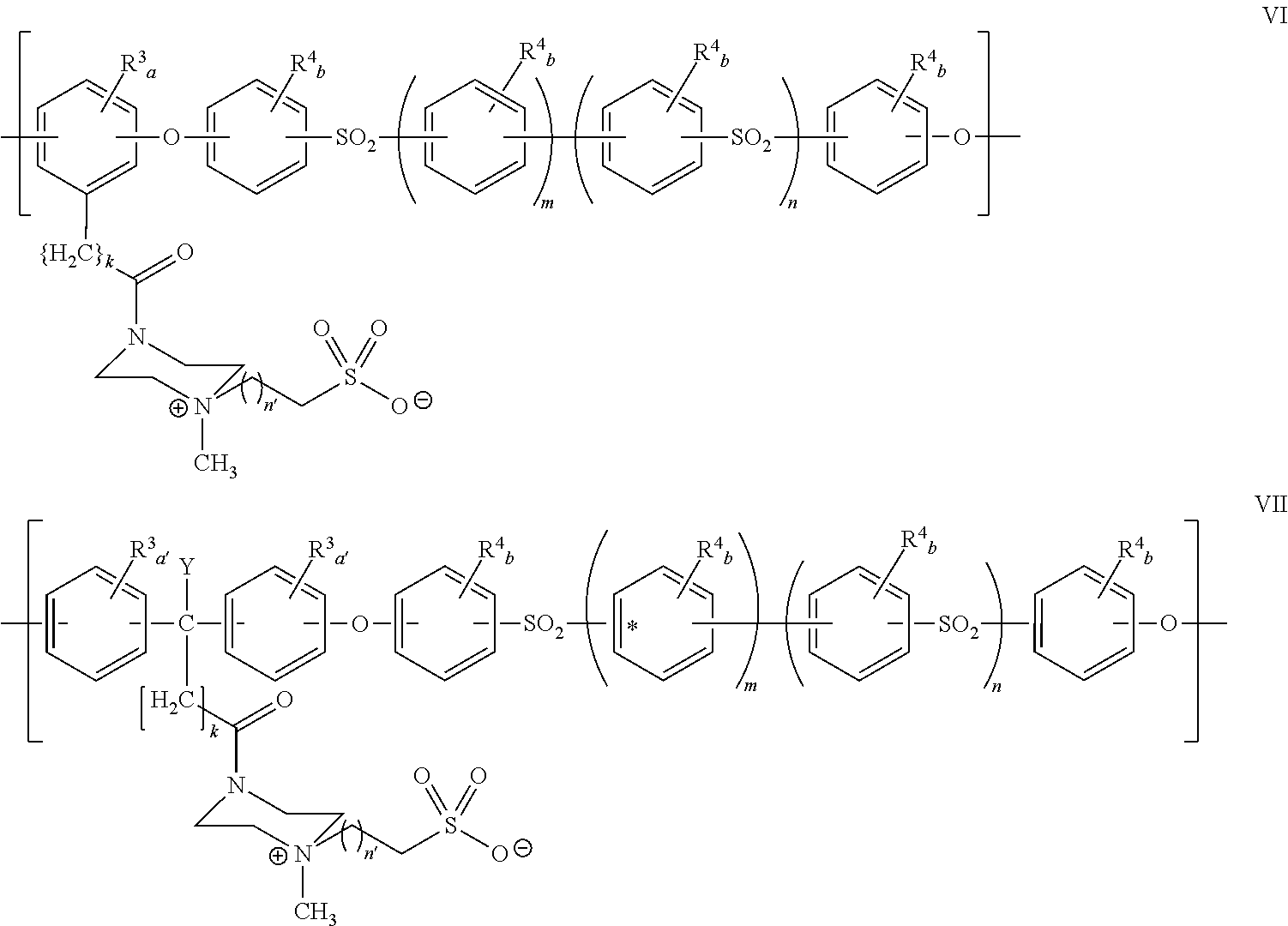Polyarylether compositions bearing zwitterion functionalities
a technology of polyarylether and functionalities, applied in the field of polyarylether compositions bearing zwitterion functionalities, can solve the problems of reduced efficiency, high cleaning and maintenance costs, and less ideal aqueous applications such as hemodialysis and protein separation, and achieve the effect of enhancing hydrophilicity and biocompatibility
- Summary
- Abstract
- Description
- Claims
- Application Information
AI Technical Summary
Benefits of technology
Problems solved by technology
Method used
Image
Examples
example i
Synthesis of Monomers: Diphenolic Acid Methyl Ester
[0121]
[0122]Diphenolic acid (500 g) and methanol (1 liter) was charged into a three-neck flask equipped with nitrogen inlet, mechanical stir, and condenser. To this solution was added concentrated H2SO4 (18 ml). The solution was heated at 78° C. for 24 hours. The solution was collected and evaporated in vacuo. The solid was collected, and washed with excess of water. The solid was dried in vacuo to afford 502 g (96% yield) of the monomer.
example ii
Synthesis of Monomers: Diphenolic Acid Piperizine Amide
[0123]
[0124]A mixture of diphenolic acid methyl ester (20 g) and N-methylpiperazine (20 g) was heated to 185° C. for 7 hour, until NMR showed 100% conversion of the starting material. The solution was cooled to 100° C. To this solution was added acetone (67 ml) and water (27 ml). The solution was evaporated at 110° C., until a large amount of white powder forms. The solution was cooled to room temperature, and 40 ml of 15% aqueous acetone solution was added. The white solid was filtered, and dried in vacuo to afford the amide (20.8 g, 85% yield).
example iii
Synthesis of Polymers with Diphenolic Acid Piperazine Amide, BPA, and Dichlorodiphenylsulfone
[0125]
[0126]Diphenolic acid piperazine amide (2.211 g, 6 mmol), BPA (1.37 g, 6 mmol), and potassium carbonate (18.0 mmol, 2.49 g) were transferred into a three-neck flask equipped with a Dean-Stark trap, nitrogen inlet, and mechanical stirrer. DMSO (6 ml), and toluene were added. The mixture was stirred at 165° C. The water generated was removed. After 2 hours, the reaction mixture was cooled, before dichlorodiphenylsulfone (3.446 g, 12 mmol) was added. The reaction mixture was stirred at 180° C., until a very viscous solution was obtained. The reaction mixture was diluted with DMAC, and precipitated in water. The polymer, isolated by vacuum filtration, was washed with water and methanol respectively, and dried in vacuo at 70° C.
PUM
| Property | Measurement | Unit |
|---|---|---|
| Tg | aaaaa | aaaaa |
| Tg | aaaaa | aaaaa |
| Tg | aaaaa | aaaaa |
Abstract
Description
Claims
Application Information
 Login to View More
Login to View More - R&D
- Intellectual Property
- Life Sciences
- Materials
- Tech Scout
- Unparalleled Data Quality
- Higher Quality Content
- 60% Fewer Hallucinations
Browse by: Latest US Patents, China's latest patents, Technical Efficacy Thesaurus, Application Domain, Technology Topic, Popular Technical Reports.
© 2025 PatSnap. All rights reserved.Legal|Privacy policy|Modern Slavery Act Transparency Statement|Sitemap|About US| Contact US: help@patsnap.com



